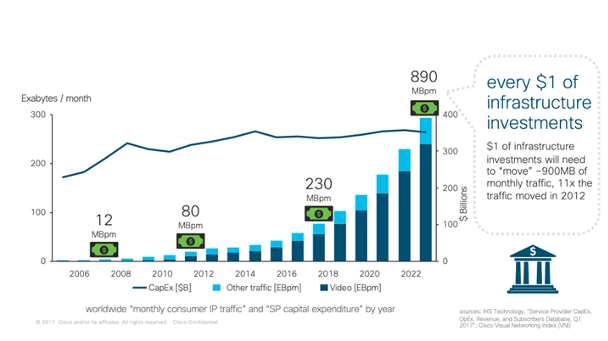Over the last couple of years, Service Providers have been facing challenges addressing the exponential traffic growth of their networks given a flat Average Revenue Per User (ARPU) figure. Market research shows that traffic has and will see a compounded annual growth rate of 30 percent or higher with more devices connected, and more content being consumed. Services like video, gaming, virtual/ augmented reality, etc. will create a huge surge in traffic demands that will have a direct impact on Infrastructure. It is estimated that a service provider will need to move 11 times more traffic per $1 of infrastructure investment in 2022 when compared to what it was in 2012.

The network demand has further exploded with bandwidth challenges created by virtual work from home/study from home as ‘the new normal’.
In order to remain competitive, the onus is on service providers to achieve the following objectives:
1) Ensure networks meet the demand for this new capacity,
2) Offer New Revenue Generating Service
3) Lower operational expenditure (OPEX) and capital expenditure (CAPEX)
The Evolution of Technology
Technology is evolving following Moore’s Law, and we continue to push and get closer to Shannon’s limits.
From an operational perspective we see a strong push to leverage on Automation, SDN, Telemetry, Machine Learning, and Artificial Intelligence that will help make networks smarter, at the same time lower the overall OPEX spend.
From a network architecture point-of-view, we continue to see investments in individual network layers with each layer evolving around capacity and flexibility in a siloed manner; which contributes to the cost and complexity of the overall network infrastructure. To solve this complexity and reduce CAPEX spent on these siloed networks, a more converged and disruptive strategy is needed in order to build a network with scale, efficiency, and the capacity to accommodate exponential traffic growth.
Transformative Approach- Integrate, Converge, Simplify
Traditional network architectures are comprised of network layers that are highly inefficient, as each networking layer has its own control and management planes associated with it that operate independently from each other. This creates huge complexities in service assurance, fault correlation, path optimization in terms of network utilization, as well as network planning and optimization. These complexities represent challenges to service providers’ aspirations towards achieving service-driven end-to-end, closed-loop automation across the entire network infrastructure.
In order to address these pain points and to allow networks to scale effectively to meet traffic projections, Cisco advocates a new Converged SDN Transport Architecture to simplify networks while driving increased scale and lower TCO for IP services.
Cisco is committed to addressing these challenges by applying simplification through key technology that brings about true convergence of the IP and optical domains. Network simplification is aimed at removing complexities inherent to the infrastructure in order to allow service providers to leverage their assets more effectively. These initiatives are embodied in the Converged SDN Transport architecture framework, a key enabler for the realization of Cisco’s vision for the Internet for the Future.
Find Out More
Read the whitepaper on Cisco Converged SDN Transport Architecture to discover how new advances in silicon photonics and a closed-loop automation framework across single converged IP and Optical Infrastructure have become key components for architects building tomorrow’s profitable networks.

NIce concept